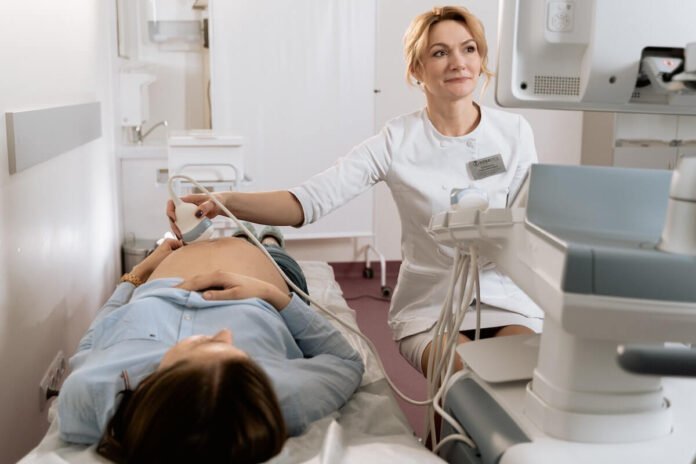Explanation of CVS
Chorionic villus sampling (CVS) is a prenatal diagnostic test that involves taking a small sample of cells from the placenta, which is the organ that provides oxygen and nutrients to the developing fetus. The procedure is typically performed between 10 and 13 weeks of pregnancy and can be done either through the abdomen or vagina, depending on the location of the placenta. CVS is used to detect genetic disorders such as Down syndrome, cystic fibrosis, and sickle cell anemia.
During CVS, a thin needle or catheter is inserted into either the abdomen or vagina and guided toward the placenta using ultrasound imaging. A small amount of tissue from the chorionic villi – tiny finger-like projections on the surface of the placenta – are then removed for analysis in a laboratory. The results of CVS are typically available within one to two weeks.
Although CVS has a high accuracy rate for detecting genetic disorders, there are some risks associated with it. These include miscarriage (1 in 200 procedures), infection, bleeding, and limb defects if performed before nine weeks gestation. Women who undergo CVS should discuss these risks with their healthcare provider beforehand and make an informed decision about whether or not to proceed with testing.
Who Should Consider CVS
CVS, also known as chorionic villus sampling, is a prenatal diagnostic test that involves taking a small sample of cells from the placenta for analysis. This procedure is typically recommended for women who are at an increased risk of giving birth to a child with genetic disorders or chromosomal abnormalities. Women over the age of 35, those with a family history of genetic conditions and those who have had abnormal results from other prenatal tests may be advised to consider CVS.
The procedure can help identify genetic conditions such as Down syndrome and cystic fibrosis before birth, allowing parents to make informed decisions about their pregnancy and prepare for the future. However, like any medical procedure, it does come with some risks. There is a small chance of miscarriage (around 1%) and there may be some discomfort during the procedure.
It is important to talk to your healthcare provider if you are considering CVS to determine if it is the right choice for you based on your individual circumstances and medical history. They can provide more information on what to expect during the procedure and answer any questions or concerns you may have.

High-risk pregnancies
For high-risk pregnancies, prenatal chromosomal analysis is essential to monitor the development of the fetus. Chorionic Villus Sampling (CVS) is one procedure that can be done to collect chorionic tissue samples from a developing placenta for analysis. This procedure is usually performed between weeks 10 and 12 of pregnancy and can help detect genetic abnormalities, such as Down syndrome.
However, this procedure does come with some risks. CVS carries a small chance of miscarriage, which is why it is typically only recommended for women who are at high risk for genetic disorders or have abnormal ultrasound results. It’s important to discuss the potential risks and benefits with your healthcare provider before deciding whether or not to undergo CVS testing.
Overall, while CVS can provide important information about the health of an unborn baby in high-risk pregnancies, it should only be considered after careful consideration and consultation with a healthcare provider.
How Is CVS Done
Before undergoing CVS, it is important to receive genetic counseling. This can help you understand the risks and benefits of the procedure, as well as prepare you for any potential outcomes. During the procedure itself, a small sample of cells is taken from the chorionic villi, which are finger-like projections in the placenta. The sample can be taken either transabdominally or transcervically.
Transabdominal CVS involves inserting a needle through the abdomen to reach the placenta. This is typically done under ultrasound guidance to ensure accuracy. Transcervical CVS involves inserting a thin tube through the cervix and into the uterus to reach the placenta. Both methods carry some risks, including miscarriage and infection, although these risks are relatively low.
After the sample is collected, it will be sent to a laboratory for analysis. Results can take several days or weeks to come back depending on which tests are being done. It’s important to discuss your results with your healthcare provider so that you fully understand what they mean and how they may impact your pregnancy moving forward.
Procedure and process explained
Before undergoing a CVS procedure, it is important to receive genetic counseling from a healthcare professional. This counseling will help you understand the risks and benefits of the procedure, as well as any potential outcomes. The counselor may also discuss alternative testing options.
During the actual CVS procedure, a small sample of tissue is taken from the placenta using either a needle or catheter. This tissue contains cells that can be analyzed for genetic abnormalities or disorders. The procedure typically takes around 30 minutes and may cause mild discomfort.
After the CVS procedure, it is important to rest and avoid strenuous activity for at least 24 hours. Results from the analysis of the tissue sample are typically available within two weeks and will be reviewed with you by your healthcare provider. It is important to continue any recommended prenatal care and monitoring throughout your pregnancy regardless of the results of this test.
Risks and Potential Complications
One of the most significant risks associated with chorionic villus sampling (CVS) is fetal loss. According to a study conducted by the Royal College of Obstetricians and Gynaecologists, the risk of miscarriage following CVS is approximately 1%. This risk increases slightly if the procedure is performed before 10 weeks gestation. However, it’s important to note that this risk is still relatively small compared to other prenatal diagnostic tests.
Another potential complication of CVS is infection. The procedure involves inserting a needle through the mother’s abdomen or cervix and into the placenta to collect a sample of cells. In rare cases, this can introduce bacteria into the uterus, potentially leading to an infection. Symptoms may include fever, chills, pain or tenderness in the abdomen, foul-smelling vaginal discharge or bleeding after the procedure.
Finally, some women may experience cramping or spotting after undergoing CVS. These symptoms typically resolve on their own within a few days but should still be reported to your healthcare provider if they occur. Overall, while there are some risks associated with chorionic villus sampling (CVS), it remains one of the most accurate ways to diagnose certain genetic conditions prenatally and can provide families with valuable information about their baby’s health early in pregnancy.
Associated risks and potential complications
One of the potential risks associated with chorionic villus sampling (CVS) is miscarriage. The risk varies depending on several factors, including when the procedure is performed and the skill level of the person performing it. In general, the risk of miscarriage from CVS is estimated to be between 0.5% and 1%, which means that out of every 100 women who have CVS, one may experience a miscarriage as a result.
Another potential complication of CVS is infection. Any time an invasive procedure is performed, there is a risk of introducing bacteria or other microorganisms into the body. To reduce this risk, doctors typically use sterile techniques during CVS procedures and prescribe antibiotics to prevent infection afterward. However, in rare cases, infection can still occur and may require treatment with additional antibiotics or even hospitalization.
Understanding the results of chorionic villus sampling can also be challenging for some women and their families. Depending on what condition was being tested for, results may be inconclusive or indicate a higher-than-average chance that a baby will have a particular genetic disorder. This can be stressful and emotionally difficult to cope with, especially if further testing or decisions about pregnancy management need to be made based on those results. Genetic counseling can help provide support and guidance during this process.
Results and Follow-Up Care
One of the most crucial aspects of undergoing CVS is the emotional support that follows after the procedure. As a highly invasive prenatal diagnostic test, many women experience a great deal of anxiety and stress before, during, and after the procedure. It is vital for healthcare providers to offer support in the form of counseling or referrals to mental health professionals who can help patients cope with any negative emotions they may be feeling.
Another important aspect to consider after undergoing CVS is follow-up care. Although it is a highly accurate test for detecting genetic disorders in fetuses, there are also some limitations to its accuracy. Women who undergo CVS should be informed about these limitations and given guidance on what actions they should take if their results come back abnormal. This may include additional testing or referral to specialists who can provide further guidance on next steps.
Overall, while there are benefits and limitations to chorionic villus sampling, it is crucial that healthcare providers offer emotional support and adequate follow-up care for women who undergo this test. By doing so, they ensure that patients have the resources they need to navigate any potential challenges that may arise as a result of their test results.
Interpretation of results and necessary follow-up care
After undergoing a prenatal diagnosis like chorionic villus sampling (CVS), waiting for the results can be an anxious time for expectant parents. Once the results are in, it is important to have them interpreted by a healthcare professional to determine what actions need to be taken. If there are any abnormalities or concerns, additional testing may be necessary or referral to a specialist may be required.
Depending on the nature of the results, follow-up care may vary. For example, if CVS reveals that the baby has a genetic disorder or chromosomal abnormality, parents will need to discuss their options with their doctor and make decisions about how they want to proceed with their pregnancy. In some cases, early delivery or termination may be recommended. Parents should also receive counseling and support during this time from qualified healthcare professionals who can help them understand their options and cope with any emotional distress they may experience.
Alternative Testing Options
Alternative testing options to chorionic villi sampling (CVS) include amniocentesis and non-invasive prenatal testing (NIPT). Amniocentesis involves the insertion of a needle into the womb to extract a small amount of amniotic fluid, which contains cells from the baby. NIPT, on the other hand, is a blood test that analyzes fetal DNA in maternal blood.
Compared to CVS, both amniocentesis and NIPT have lower risks of miscarriage and injury to the fetus. However, they may not provide as much information about certain genetic disorders as CVS does. It is important for pregnant women to discuss with their healthcare provider which testing option is best for them based on their individual circumstances.
Regardless of which testing option is chosen, it’s important for pregnant women to understand and consider all potential risks and safety considerations. This includes understanding the possibility for false positives or false negatives in test results, as well as any physical discomfort or emotional stress associated with undergoing these procedures.
Other prenatal testing options available
When it comes to prenatal testing, Chorionic Villus Sampling (CVS) is another option available. CVS is a diagnostic test that involves taking a small sample of cells from the placenta, which is then analyzed for genetic abnormalities. This test can be performed as early as 10 weeks into pregnancy and results usually take about 1-2 weeks to come back.
CVS may be recommended during pregnancy if there is an increased risk of chromosomal abnormalities or genetic disorders. This could occur if a woman is over the age of 35, has had abnormal results from previous screening tests, or has a family history of certain genetic conditions. It’s important to note that while CVS can provide more accurate results than other screening tests, it does have a slightly higher risk of miscarriage.
Other prenatal testing options include Non-Invasive Prenatal Testing (NIPT), which involves analyzing fetal DNA in the mother’s blood to screen for chromosomal abnormalities; Amniocentesis, which involves taking a sample of amniotic fluid for analysis; and Ultrasound screenings throughout pregnancy to monitor fetal development and identify any potential issues early on. It’s important for expecting parents to discuss their options with their healthcare provider and make informed decisions based on their individual circumstances and preferences.
Common Questions
Q: What is chorionic villus sampling?
A: Chorionic villus sampling (CVS) is a prenatal test that is performed to detect any abnormalities or genetic disorders in the fetus. It involves the removal of a small sample of cells from the placenta, which is the tissue that connects the developing fetus to the mother’s uterus.
Q: How is the CVS procedure performed?
A: During the CVS procedure, a needle is inserted into the uterus either through the cervix or through a small incision in the abdomen. The doctor then guides the needle towards the placenta using ultrasound guidance. Once the needle is in place, a small sample of the placental tissue is collected with the help of a syringe.
Q: What are the risks of chorionic villus sampling?
A: Like any medical procedure, chorionic villus sampling carries certain risks. The risks may include infection, bleeding, or damage to the fetus. However, these risks are relatively rare and occur in less than 1% of cases.
Q: What are the benefits of getting a CVS test performed?
A: The main benefit of CVS is that it can help parents identify any potential genetic problems in their unborn child. This information can help parents make more informed decisions about their pregnancy, including whether to continue the pregnancy or prepare for the arrival of a child with a genetic disorder.
Q: How long does it take to get the results of the CVS test?
A: The time it takes to get the results of the CVS test may vary depending on the medical center where the test is performed. However, most labs can provide results within 1-2 weeks.
Q: How is the chorionic villus sampling for prenatal diagnosis used to diagnose genetic diseases?
A: Chorionic villus sampling for prenatal diagnosis is typically used to test for chromosomal abnormalities, such as Down syndrome, or neural tube defects. It can also be used to determine paternity in some cases.
Q: Do I need to see a genetic counselor before getting a CVS test?
A: It is generally recommended that women who are considering CVS test should see a genetic counselor beforehand. A genetic counselor can help parents understand the risks and benefits of the test, as well as discuss any concerns they may have about their pregnancy.
Q: Is chorionic villus biopsy the same as CVS?
A: Yes, chorionic villus biopsy is another term that is used to describe the CVS procedure. Both terms refer to the removal of a small sample of cells from the placenta for prenatal diagnosis.
Q: What happens during the CVS test procedure?
A: During the CVS test procedure, a small sample of chorionic villi is extracted from the placenta using a needle. This sample is then sent to a lab where it is analyzed for any genetic problems or abnormalities.
Q: How can I be in a better position for the CVS procedure?
A: To be in a better position for the CVS procedure, you should make sure that you are well-rested and hydrated before the test. It may also be helpful to empty your bladder before the test, as a full bladder can make it difficult for the doctor to reach the placenta.

